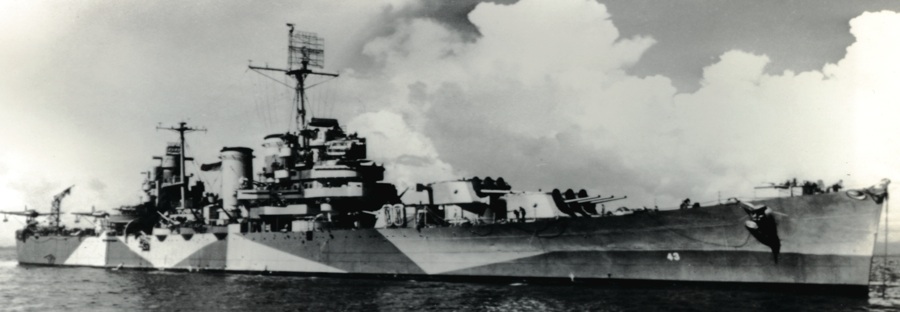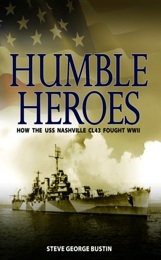uss nashville cl43

Humble Heroes, How The uss nashville cl43 fought wwii
a Story of a heroic ship and the personal experiences of her crew
The Pacific Theater in WWII was America’s second priority, after the European Theater of operations. Despite the fact that America was brought into the war by the shameful Japanese attack on the US naval base at Pearl Harbor and that the Japanese captured ten times the amount of territory the Germans did, Roosevelt and the War Department rightly felt that America’s first priority must be saving Britain and defeating Nazi Germany and Fascist Italy, while maintaining the fight in the Pacific against the Japanese until the industrial might of the country could adequately supply both. Hence, the war in the Pacific saw America operate in the role of underdog in men, material, and experience until well past the Battle of Midway.
By the end of the war the Pacific was akin to an American lake. More than 90% of the naval vessels afloat on the planet were American, as America’s shipyards turned out carriers, battleships, cruisers, destroyers, submarines, and a multitude of support and landing craft during the war. But during the early dark months, devoid of victory, with much of the American fleet resting in the mud of Pearl Harbor, ships and men of the line were in dangerously short supply. Few of those early brave vessels survived throughout the war. The Nashville was one of them, serving from the first day to the last, and beyond.
The USS Nashville, CL-43, a Brooklyn Class light cruiser, was awarded ten Battle Stars during WWII, more than any other Brooklyn Class cruiser. She and her crew served from the North Atlantic to the South Pacific, from the Aleutians to China, and almost everyplace in between. Her keel laid down on January 24, 1935 and commissioned on June 6, 1938, the ship and her crew served with great heroism and effectiveness throughout the entire war. Like other light cruisers, she was designed to defend smaller vessels, be a sole raiding force due to her power and speed, scout dangerously ahead of main task forces, provide support bombardment, and serve as a ship of the line during enemy naval engagements. She did all of this and far more than her designers had envisioned. There are no WWII cruisers turned museum in the United States, unlike carriers, battleships, Liberty ships, a range of others, and even a Higgins boat. Of the forty-seven American light cruisers that battled the enemy in WWII, each and every one that survived the war was sold or unceremoniously cut into scrap.
She is not the best known of the multitude of famous US Navy ships of WWII marketed into public consciousness, great ships like Enterprise, Hornet, Arizona, and Missouri, all of which are museums or a national cemetery in the case of the ill-fated Arizona. In fact, Nashville is not famous or known at all unless you are a student of history in general, and most likely only of US Navy history of WWII. Yet, she served her country and crew well, fought against heavy odds, secretly transported $25 million in British gold bullion, participated in one of the most daring raids in US Navy history sinking the first Japanese surface vessels of the war as a result of offensive action, acted as flagship for General McArthur in his return to the Philippines, survived a devastating direct hit by a kamikaze, and eventually brought US troops home from the war. Her crew took heavy casualties but most returned home safely to start families and go about their lives without most people knowing their wartime experiences. These men, like others of the so-called Greatest Generation, waited half a century in many cases before they learned to share, ever so humbly, their wartime experiences not only with a younger generation, but in many cases with their own families. And what they have collectively shared is certainly but a fragment of their experiences. Hence, the story of the Nashville is typical of US Navy ships serving in the Pacific Theater during WWII.
This book is the story of her crew, a community of more than 1,000 men in harm’s way, which in turn is the story of, in one way or another, all US servicemen and women of WWII, a story of the everyday heroism of getting the job done when America needed them. As Nashville crewman Marine Sgt. Don Hill put it, “We had a job to do and we did it, and we put in a lot of overtime doing it.” It was a ship that bound young men together in ways few, if any, had foreseen at the time. Fully sixty years after the end of the war, the few crewmen alive and able to do so traveled to their latest reunion. Their feelings were perhaps best summed up by one old salt who said, “I never felt love in my life like I did from the crew of the Nashville.”
I had the privilege and pleasure of meeting many of the surviving Nashville crew during the writing of this book, and of talking on the phone or exchanging letters and emails with even more. Their passion for life, tenacity in meeting challenges, humor in dealing with physical and emotional pain, and camaraderie among themselves were easily evident. But their most telling, encompassing, and impressive characteristic was their sincere humbleness about their service during the war. All of these men, most whom were teenagers at the time, played an integral role in the winning of the war. All of them were in danger at various times and all of them saw the grotesqueness of war. Many displayed stunning acts of heroism in defense of their ship and the care of their shipmates. Yet never once during hundreds of conversations did I hear a boastful remark from a crew member in regards to his role and actions. They were proud and boastful about the ship and their shipmates, never about themselves. They truly were, and are, humble heroes.
Table of contents

“Top Secret” mystery missions, many without other ships in support, were becoming uncomfortably familiar for the crew of the USS Nashville CL43. It started like a Hollywood thriller, secretly transporting from England $25 million in British gold bullion, delivered to the ship in unguarded bread trucks, a pre-war “Neutrality Patrol” that was really an unofficial hostile search for the far bigger and more powerful German battleship Prinz Eugen, and sneaking through the Panama Canal at night with the ship’s name and hull number covered for secrecy.
Now, with the ship bulging with an unusual load of fuel and supplies, in the company of a large fleet quietly passing under San Francisco’s Golden Gate Bridge, the crew was about to learn of their latest (but not last) and most improbable adventure yet as the captain made an announcement that would change the war and their lives forever, “We are going to Tokyo!”. Over three years, scores of battles and hundreds of thousands of ocean miles later, the Nashville and her crew had earned 10 Battle Stars, served from the North Atlantic to the South Pacific, from the Aleutians to the Yangtze River, as McArthur’s flagship and suffered heavy casualties from a devastating kamikaze attack. Tokyo Rose reported her sunk, repeatedly.
Earlier, with goodwill trips that included France, England, Scandinavia, Bermuda and Rio de Janeiro, the new, sleek Nashville built a pre-war reputation as a “glamour ship”. But with war came the secret missions, capturing the second and third Japanese POWs of the war, having a torpedo pass just under the stern, being strafed and bombed by Japanese planes, losing a third of the crew in a single devastating Kamikaze attack, swimming in shark infested waters protected by marines with machine guns, enjoying the beauty of Sydney and her people, planning a suicide mission to destroy the Japanese fishing fleet, and bombarding Japanese troops and airfields across the Pacific.
The Nashville crew served their ship and country well. They came from Baltimore row-houses, New York walk-ups, San Francisco flats, Kansas wheat farms, Colorado cattle ranches, Louisiana bayous and Maine fishing towns. Many had never traveled more than 25 miles from home and had never seen the ocean until they joined the service. They were part Irish, part Italian, part Polish and All-American. Battered, burnt and bombed, they made the USS Nashville their home and lived and died as eternal shipmates. Historical narrative enriched with the personal stories of the crew, this is the story of a ship and crew of ordinary men who did extraordinary things.
Chapter 1 Build Up: Shakedown
Chapter 2 Good Times: Bad Beginning
Chapter 3 The Halsey-Doolittle Raid: Shoot, Sink and Rescue
Chapter 4 North to Alaska: Fog, Freeze, Bombs, and Boredom
Chapter 5 War in the Pacific: Tragedy Strikes
Chapter 6 War in the Pacific: More Islands
Chapter 7 Biak: Near Miss Nearly Hit
Chapter 8 Kamikaze: Hell on Deck
Chapter 9 Repair: Return and Fight
Chapter 10 The End of the War: New Duty
Epilogue
Postscript
purchase the book

Book Summary
author’s note
The softcover book is available online at Amazon, Borders and Target among others, or simply click on the book icon near the top of this page. Below is a link to the book page on Amazon. A Kindle version is also available.
If you wish to receive a signed, hardcover book, contact me directly. I do not charge a fee for signing the book, including any personal note you wish me to include. Contact me via email at bustin@bustinmedia.com
Amazon Link:
Click to view/purchase
Copyright 2010 Bustin Media
